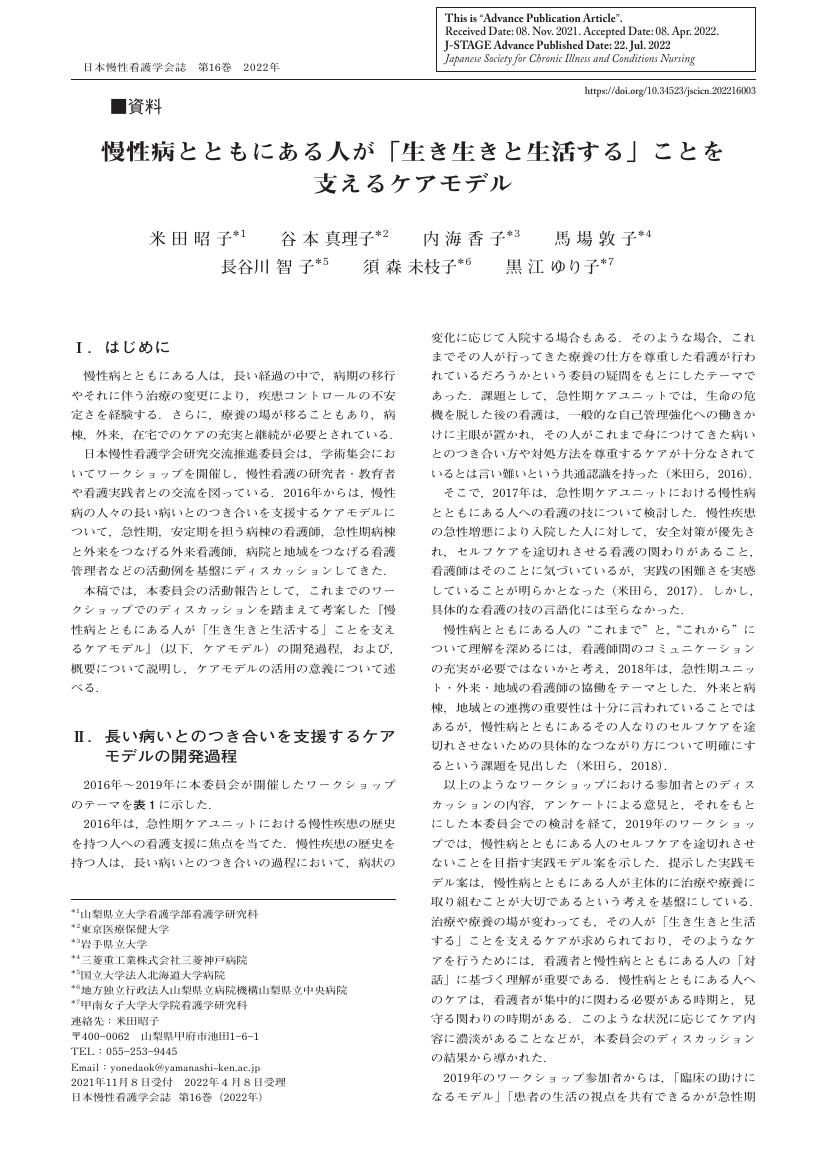2 0 0 0 OA 慢性病とともにある人が「生き生きと生活する」ことを支えるケアモデル
1 0 0 0 IR 糖尿病患者のセルフケア能力の要素の抽出 : 着護効果測定ツールの開発に向けて
- 著者
- 清水 安子 黒田 久美子 内海 香子 正木 治恵 Shimizu Yasuko Kuroda Kumiko Uchiumi Kyoko Masaki Harue シミズ ヤスコ クロダ クミコ ウチウミ キョウコ マサキ ハルエ
- 出版者
- 千葉看護学会
- 雑誌
- 千葉看護学会会誌 (ISSN:13448846)
- 巻号頁・発行日
- vol.11, no.2, pp.23-30, 2005-12-30
- 被引用文献数
- 1
本研究の目的は,糖尿病患者の看護効果測定ツールの開発に向けて,糖尿病患者のセルフケア能力の要素を抽出することである。1990年以降,千葉大学大学院看護学研究科の修士論文・博士論文で糖尿病患者を対象に看護援助や面接を通して行われた質的研究8論文を選択し,質的分析によりセルフケア能力の要素を抽出し,その要素の構造が導き出された。抽出されたセルフケア能力の要素は,【糖尿病や自己管理に関する基礎知識】【ストレス対処力】【サポート活用力】【モニタリング力】【応用力】【調整力】【自己の身体を捉える力】【自己管理の自己推進力】【糖尿病をもちつつ自己実現していく力】の9つの要素であった。セルフケアの能力の要素は,【糖尿病や自己管理に関する基礎知識】を基点に,【応用力】【調整力】を高めつつ発展する『自己管理方法の確立』という方向と,【自己の身体を捉える力】【自己管理の自己推進力】を高めつつ発展する『自己理解の深まりと自己実現』という方向の2つの方向が見出され,両方向の能力の中心に【モニタリング力】が位置づけられた。そして,これらの能力を総合的に活用していく中で,【糖尿病をもちつつ自己実現していく力】を高め,2つの方向が融合していく構造が導き出された。また,【ストレス対処力】【サポート活用力】は,この全てのプロセスで活用するセルフケア能力として位置づけられた。The purpose of this study was to extract the self-care agency elements for patients with diabetes toward the development of nursing effect measurement tools. From among the masters' and doctoral theses written by students of the Graduate School of Nursing at Chiba University after 1990, which involved the provision of nursing support for or interviews with diabetics, eight theses that dealt with qualitative study were selected to extract the self-care agency elements for diabetics by qualitative analysis. As a result, the structure of these elements was drawn. The nine self-care agency elements extracted are as follows: "basic knowledge of diabetes and self-management," "stress-coping ability," "ability to make the most of support," "monitoring ability," "application ability," "adjustment ability," "ability to obtain a clear understanding of one's body," "ability to promote self-management," and "ability to achieve self-realization despite having diabetes." With "basic knowledge of diabetes and self-management" as the starting point, the self-care agency elements are divided into two directions. One direction is toward the 'establishment of self-management methods' while enhancing "application ability" and "adjustment ability." The other is toward 'deeper self-understanding and self-realization' while enhancing the "ability to obtain a clear understanding of one's body" and the "ability to promote self-management." On the other hand, the "monitoring ability" is positioned at the center of those two directions. As a result, the structure was found wherein, the utilization of these abilities in a comprehensive manner leads to the enhancement of the "ability to achieve self-realization despite having diabetes" and the eventual fusion of the two directions. The "stress-coping ability" and the "ability to make the most of support" are positioned as the abilities used in all processes.
